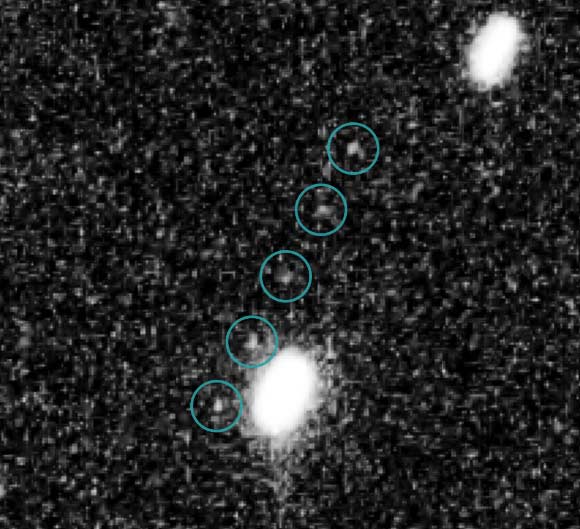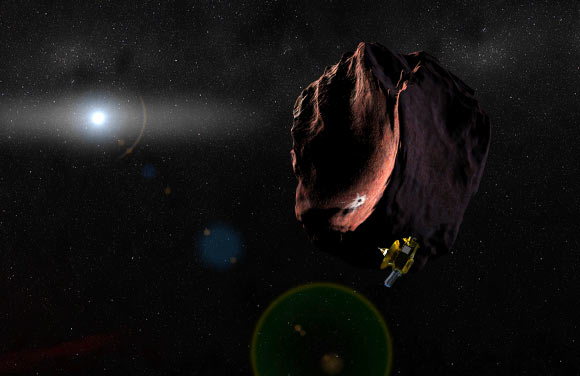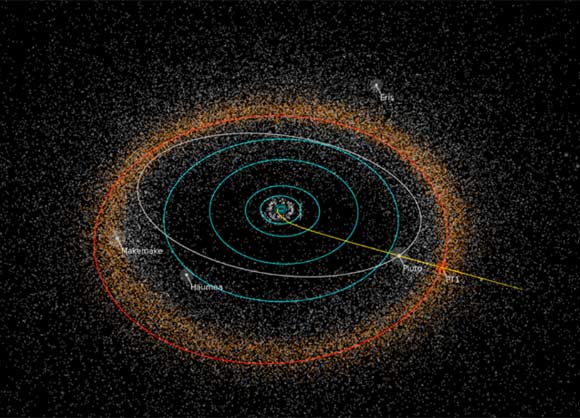The next destination for NASA’s New Horizons spacecraft is a Kuiper Belt object known as 2014 MU69.

Hubble images of 2014 MU69 taken on June 24, 2014. The images were taken at 10-min intervals. The positions of 2014 MU69 in the images are shown by the green circles. Image credit: NASA / ESA / SwRI / JHU / APL / New Horizons KBO Search Team.
2014 MU69, nicknamed PT1 (Potential Target 1), is a small Kuiper Belt object (KBO) about 4.1 billion miles from the Sun and about half a billion miles from Pluto. It was discovered on 26 June 2014 by the NASA/ ESA Hubble Space Telescope.
This KBO orbits the Sun once every 293 years and is estimated at 30 miles (48 km) in diameter, that’s more than 10 times larger and 1,000 times more massive than typical comets, but only about 0.5 to 1 percent of the size of Pluto.
As such, 2014 MU69 is thought to be like the building blocks of Kuiper Belt planets such as Pluto.
2014 MU69, also known as 1110113Y, is a “great choice because it is just the kind of ancient KBO, formed where it orbits now,” said Dr Alan Stern of the Southwest Research Institute, principal investigator for New Horizons.
“Moreover, this KBO costs less fuel to reach, leaving more fuel for the flyby, for ancillary science, and greater fuel reserves to protect against the unforeseen.”

Artist’s impression of New Horizons encountering a Pluto-like object in the distant Kuiper Belt. Image credit: NASA / JHUAPL / SwRI / Alex Parker.
New Horizons will perform a series of four maneuvers in late October and early November to set its course toward 2014 MU69, which it expects to reach on January 1, 2019. Any delays from those dates would cost precious fuel and add mission risk.
The spacecraft was originally designed to fly beyond the Pluto system and explore additional KBOs.
“The spacecraft carries extra hydrazine fuel for a KBO flyby; its communications system is designed to work from far beyond Pluto; its power system is designed to operate for many more years; and its scientific instruments were designed to operate in light levels much lower than it will experience during the 2014 MU69 flyby,” Dr Stern said.
“There’s so much that we can learn from close-up spacecraft observations that we’ll never learn from Earth, as the Pluto flyby demonstrated so spectacularly,” said New Horizons team member Dr John Spencer, also of the Southwest Research Institute.
“The detailed images and other data that New Horizons could obtain from a KBO flyby will revolutionize our understanding of the Kuiper Belt and KBOs.”

Path of New Horizons toward its next potential target, 2014 MU69. Image credit: NASA / JHUAPL / SwRI / Alex Parker.
2014 MU69 was one of two identified as potential destinations and the one recommended to NASA by the New Horizons team. Although NASA has selected the object as the target, as part of its review process the agency will conduct a detailed assessment before officially approving the mission extension to conduct additional science.
Finding a suitable KBO flyby target was no easy task. Starting a search in 2011 using ground-based telescopes, New Horizons scientists found several dozen KBOs, but none were reachable within the fuel supply available aboard the spacecraft.
The Hubble Space Telescope came to the rescue in summer 2014, discovering five objects, since narrowed to two, within New Horizons’ flight path.







